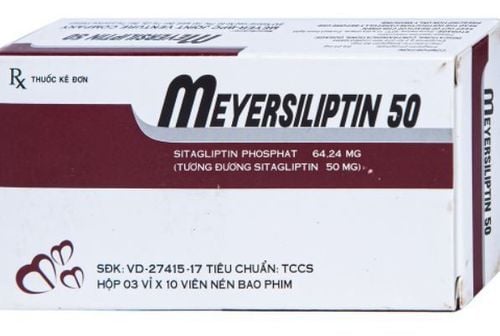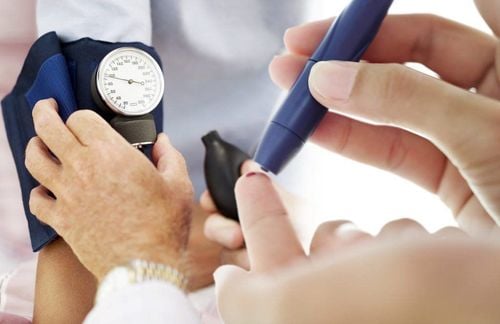This is an automatically translated article.
Glysta Tablets 90 belongs to the group of hormones, hormones, often used in the treatment of diabetes. To ensure the most effective and safe use of Glysta Tablets 90, patients need to understand the basic information about the drug.
1. What is Glysta Tablets 90?
Glysta Tablets 90 is a pharmaceutical drug belonging to the group of hormones, hormones produced by Ajinomoto Pharma Co., Ltd of Japan.
The drug with the main ingredient is Nateglinide 90mg is often used with diet and exercise to treat diabetes.
Glysta is prepared in the form of film-coated tablets, packed in the following specifications: Box of 10 blisters x 10 tablets, box of 50 blisters x 10 tablets or box of 10 blisters x 21 tablets and box of 30 blisters x 21 tablets.
2. What disease is Glysta Tablets 90 used for?
2.1. Active ingredients Glysta Tablets 90 Ingredients Nateglinide is an amino acid derivative that lowers blood sugar by stimulating insulin secretion from the pancreas .
This ingredient is used as monotherapy to lower blood sugar in patients with type 2 diabetes (non-insulin dependent diabetes) that cannot be controlled by diet, exercise and who The disease is not chronically treated with other diabetes medications.
Nopik is also indicated for use in combination with Metformin for patients with high blood sugar inadequately controlled by Metformin
2.2. Glysta Tablets 90 (Nateglinide) is indicated as an adjunct to diet and exercise to improve and control blood sugar in patients with type 2 diabetes.
2.3 Contraindications to using Glysta Tablets 90 Glysta medicine is not recommended for use in one of the following cases:
Patients with a history of hypersensitivity to Nateglinide or other ingredients in the drug. Diabetic patients with severe ketoacidosis, coma or pre-coma. Patients with severe renal dysfunction require hemodialysis while taking this medicine. Patients with serious infections or trauma, patients before or after surgery should not take the drug. Women who are pregnant or suspected of being pregnant should be cautious and consult a doctor. The drug is not for use in patients with type 1 diabetes.
3. Usage, dosage of Glysta Tablets 90
Uses of Glysta Tablets 90 will be fully effective if used correctly and at the right dose. Therefore, users should adhere to the medication prescribed and directed by the doctor or refer to the usage and dosage below:
How to use:
The drug is taken orally about 10-30 minutes before meals and The medicine should be taken with cooled boiled water. Do not take the drug with beer, wine, alcoholic beverages, soft drinks, carbonated water, coffee... Dosage:
Nateglinide is used for adults with a single dose of 90mg x 3 times a day. If the patient does not respond well, the dose can be increased to 120mg x 3 times/day. The starting dose and maintenance dose in combination monotherapy with Metformin is 120 mg 3 times/day 10 to 30 minutes before meals. Note: This dose is for reference only, and the specific dose will depend on the progression of the disease and the response to the drug in each patient. Therefore, it is necessary to use the drug exactly as prescribed and prescribed by the doctor to achieve the best effect.
4. Handling missed dose, drug overdose
Missed dose: Take as soon as you remember, but if it is almost time for your next dose, skip the missed dose and take your next dose as planned and prescribed by your doctor. Do not take double the prescribed dose to make up for the missed dose to avoid harm to health.
Overdose: To date, no case of overdosage with Nateglinide has been reported in clinical trials. However, an overdose can lead to an excessive hypoglycemic effect. In this case, symptomatic and supportive treatment is required.
In case of emergency and danger, it is necessary to take the patient to the nearest medical center for examination and timely and effective treatment measures
5. Glysta Tablets 90 . side effects
Patients taking Nateglinide regularly may experience and occur some side effects such as: Upper respiratory infection, flu, dizziness, back pain, diarrhea, joint disease, bronchitis, cough, hypoglycemia blood.
Rare serious side effects may be convulsions or jaundice (or yellow eyes).
When there are any side effects or abnormal signs on the body after taking Glysta Tablets 90, the patient should notify the doctor immediately or go to a medical facility for advice and good indication. best.
6. Drug interactions
Drug interactions are commonly observed with Diclofenac, Digoxin and Warfarin.
Certain drugs including salicylates, nonsteroidal anti-inflammatory drugs, monoamine oxidase inhibitors (MAOIs), and non-selective beta-adrenergic blockers may increase the hypoglycemic effect of nateglinide and other diabetes medications. .
Thiazides, corticosteroids and thyroid products, sympathomimetic drugs may also reduce the hypoglycemic activity of Nateglinide.
When these drugs are administered or discontinued at the time of nateglinide administration, the patient should be closely monitored for glycemic control.
Note: To avoid drug interactions that may affect the effectiveness of Glysta Tablets 90 and other drugs you are taking, inform your treating doctor about all medications you are taking recently, including medicine, functional food or herbal medicine... to be consulted by a doctor and have the most appropriate indication.
7. Notes and cautions when using Glysta Tablets 90
In order to use Glysta Tablets 90 to maximize effectiveness, users need to note and be cautious of some of the following issues:
It is necessary to use the drug exactly as prescribed, prescribed by the doctor and according to the instructions of the doctor. producer. Do not increase or decrease the dose of the drug on your own without consulting your doctor. Caution should be exercised when administering the drug in patients with impaired liver or kidney function. Patients with ischemia or hypopituitarism, adrenal insufficiency, digestive disorders also need to be used with caution. People with malnutrition, hunger, poor diet, over-exercising, excessive alcohol consumption should also not use. The drug can affect pregnancy, so it should not be used by pregnant women. In addition, clinical studies have shown that the drug can be excreted in breast milk, so breastfeeding should be discontinued when taking the drug in women who are breastfeeding. Caution should be exercised when used in elderly patients. Use of the drug may affect the ability to operate machines and drive a vehicle if blood glucose levels are low. Therefore, the drug should not be used while driving or operating machinery.
8. How to store
Medicines need to be stored in a place where the temperature is below 30 degrees Celsius, in a cool, dry place and away from sunlight. Medicines should not be stored in places with high humidity such as bathrooms, refrigerators.
It is necessary to keep the medicine out of the reach of small children to prevent children from playing and taking the wrong medicine when it has not been prescribed, affecting health.
For cases where the drug is no longer in use, it is necessary to safely dispose of the drug according to the instructions of the doctor or the waste disposal company. Do not put the medicine in the toilet or flush it under the tap every day.
Above is all information about Glysta Tablets 90, hope to help everyone know the uses as well as how to use, dosage and note when using the drug to ensure safety for health and achieve effective treatment. best treatment.













